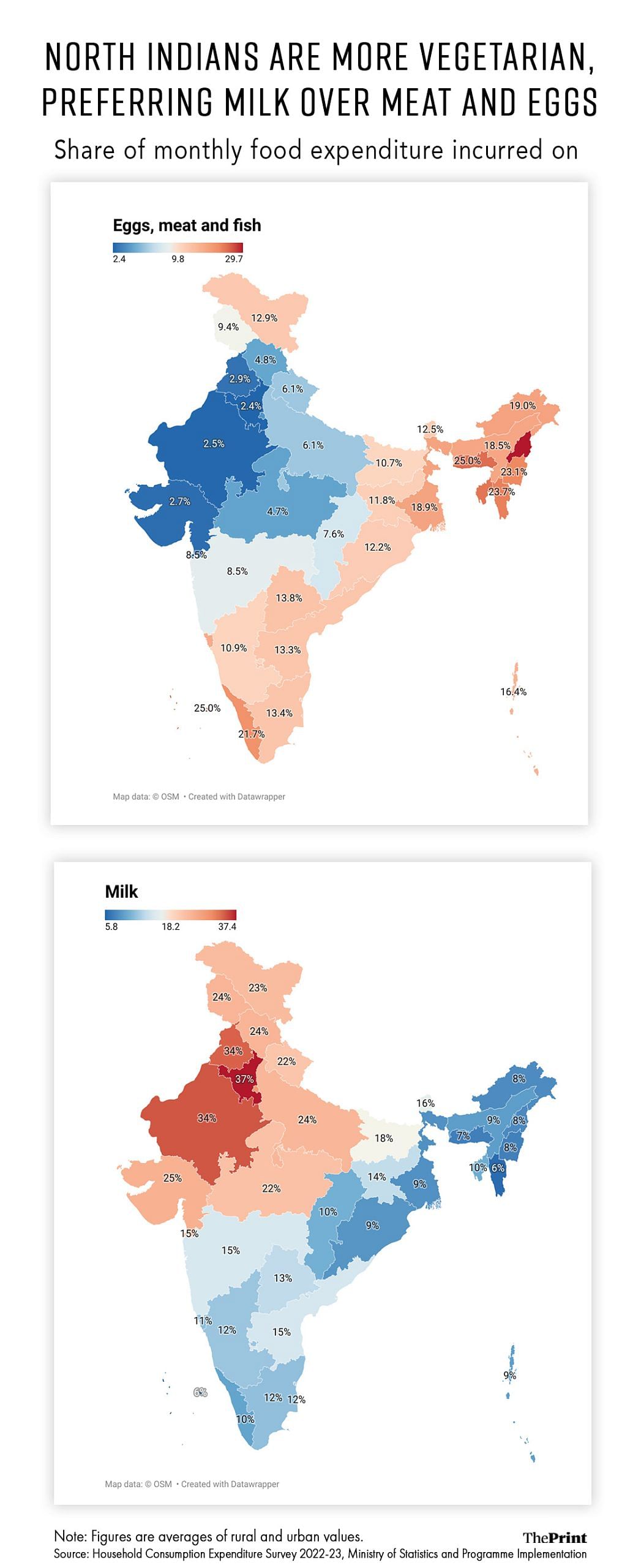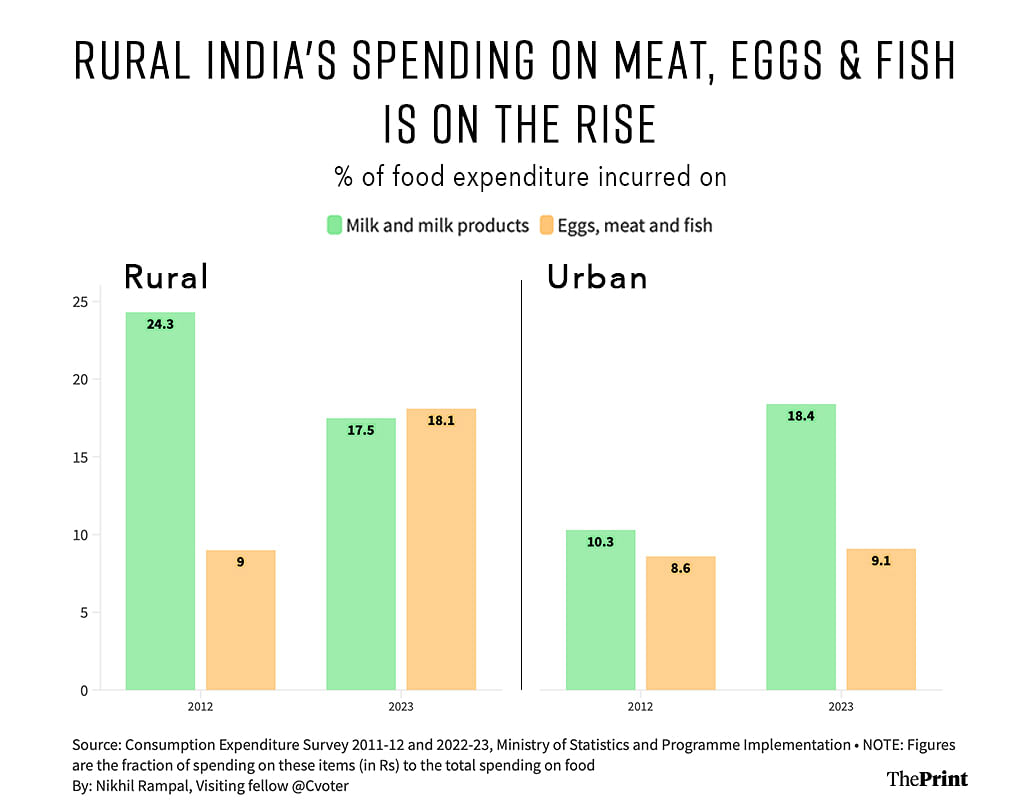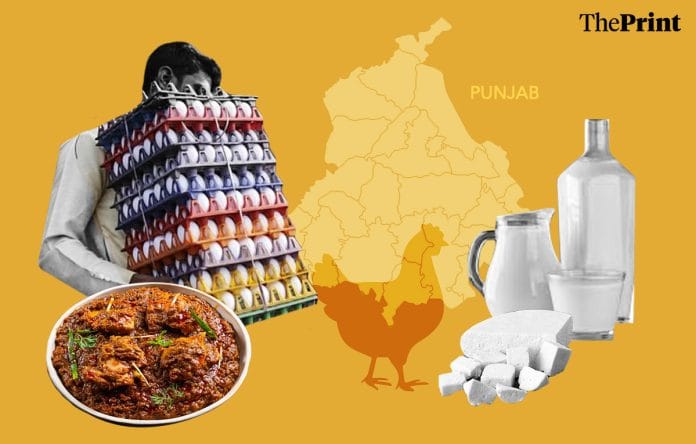Rome: Popular culture may make it seem like Punjab is home to an overwhelming number of meat-lovers, but the facts paint a very different picture. Latest statistics show that Punjabis feature among the lowest chicken- and egg-eating populations in the country.
However, they consume high quantities of milk and its products, a habit that imposes a significant burden on their wallets.
The Household Consumption Expenditure Survey (HCES) 2022-23, published by the Ministry of Statistics and Programme Implementation last month, provides details of the consumption of various food items by Indian households, including data on how Indians get their protein.
According to the survey, an average person in Punjab eats just about 205 grams of chicken in a month, almost half the amount a person in Bihar consumes during the same period — about 518 grams. In terms of eggs, too, an average Punjabi eats three eggs a month, against the figure of four in Bihar.
In fact, Punjab is among the bottom five states in terms of chicken consumption, along with its neighbours, Haryana and Rajasthan, where the average per capita monthly consumption of chicken is 133 grams and 85 grams, respectively. These states also do not consume too many eggs — barely two-three per person a month.
Gujarat also features among the bottom five in terms of chicken and egg consumption, with two eggs and 145 grams of chicken consumed per capita per month. The national average is four eggs and 410 grams of chicken a month.
Per capita consumption of chicken and eggs is the highest in the northeastern and southern parts of India. On average, the eight states in the Northeast have a monthly consumption rate of eight eggs per person. This number is six in the five southern states.
When it comes to chicken, people in southern India and the Northeast consume more than triple the amount consumed in Punjab — 681 grams in the South and 684 grams in the Northeast.
Among the top consumers of chicken in the country are Andaman and Nicobar Islands, Goa, Sikkim, Tripura and Kerala.

Alternative source of protein
Though low on meat and egg consumption, the northern and north-western states meet their protein requirements with milk and milk products. For instance, in terms of milk consumption, Haryana tops the list, with an average person consuming about 12 litres of milk each month, followed by Punjab (11), Himachal Pradesh (10), Rajasthan (10) and Jammu and Kashmir (nine).
The all-India average for the consumption of milk is about five litres a month, per capita.
Both south and northeast India fall behind in this regard, where the average milk consumption is four litres and two litres respectively. In Kerala, the per capita monthly consumption of milk is three litres, four litres each in Telangana and Karnataka, and five litres each in Andhra Pradesh and Tamil Nadu.

Paneer, a milk product, is also highly consumed in the milk-consuming belt of India. In Punjab, the average person consumes about 117 grams of paneer every month. The same figure is 172 grams in Jammu and Kashmir, 106.5 grams in Uttarakhand, 98 grams in Odisha, 92 grams in Haryana, and 87 and 85 grams in Bihar and Uttar Pradesh, respectively.
People in Rajasthan — with the lowest consumption levels of eggs and meat — consume barely 35 grams of paneer a month.
Also Read: Here are 5 key takeaways from Household Consumption Expenditure Survey 2022-2023 highlights
Costly substitution
But the substitution of meat with milk also tends to burn a hole in the pockets of people in the northern states. In Haryana, the expenditure incurred on milk and milk products accounts for 37.4 percent of their monthly food spending.
Similarly, in other milk-consuming states, milk makes up a significant share of expenditure on food.
Milk and its products make up 34.3 percent of monthly expenditure on food in Rajasthan and 33.5 percent in Punjab. In Delhi, they comprise 28.6 percent of the monthly spending on food.
In contrast, people in Bihar spend 18 percent of their food expenditure on milk and 11 percent on eggs, meat and fish. On average in India, milk and milk products constitute 18.2 percent of monthly food expenditure and eggs, meat and fish make up 10.8 percent.
ThePrint had previously reported that according to the National Institute of Nutrition’s database, dal and paneer punched below their weight in terms of protein efficiency (protein per gram, kilocalories and fat).
Meat consumption in rural India picking up
Another key highlight in the survey was that the spending on eggs, meat and fish in rural India has gone up significantly, with monthly expenditure on these items slightly above the spends on milk and milk products.
In 2011-12, the last time the HCES was conducted, meat, eggs and fish made up about 9 percent of rural India’s monthly food budget and 8.6 percent of urban India’s. By 2022-23, this share rose to 18.1 percent in rural areas, though it remained largely the same in urban areas, at 9.1 percent.

Milk and milk products constituted about 18 percent of rural India’s monthly food bills in 2011-12, which dropped to 17.5 percent in 2022-23. In urban areas, however, it rose from 10.3 percent to 18.4 percent in the same period.
This could be because milk consumption in India seems to have a relationship with income levels.
The HCES gives data on 12 fractiles or classes in the income distribution. Data shows that as income levels rise in urban areas, the share of food bills spent on milk and its products increases significantly. In other words, richer Indians tend to spend more on milk and its products, over chicken.
ThePrint calculated the ratio of spending on milk and its products to that on eggs, meat and fish. In the lowest fractiles, there is some parity. That is, in the bottom five percent of families in terms of income levels, spending on milk in the urban areas is 1.44 times the spending on eggs, meat and fish.

In the top five percent of the distribution, spending on milk (14.7 percent of food expenditure) was 2.4 times what was spent on eggs, fish and meat (6.14 percent).
In rural areas, the spending of the bottom 5 percent of households on milk and its products was only 1.24 times higher than that on eggs, meat and fish. In the top five percent, the spending on milk (18 percent of food bills) was only 1.65 times that of eggs, meat and fish (11.26 percent).
Nikhil Rampal is a visiting fellow at the CVoter Research Foundation.
(Edited by Mannat Chugh)
Also Read: Tobacco, textile and apparel manufacturing — women overrepresented in low-paying jobs






